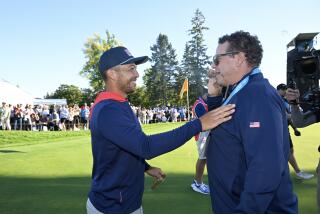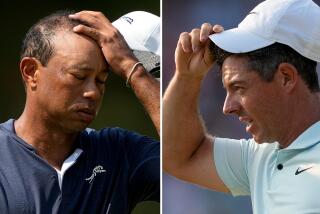U.S. OPEN TENNIS TOURNAMENT : Americans Discover That the Future Isn’t Now : Potential Successors to Connors and McEnroe Aren’t Having Much Success
- Share via
NEW YORK — While the current state of U.S. men’s tennis is being eulogized in quiet corners of the locker rooms here at the U.S. Open, the American hopes of the future have been busy beating one another’s brains out.
Two of the heirs-apparent to John McEnroe’s throne went at it Thursday in the second round of the Open at the National Tennis Center in Flushing Meadow. Paul Annacone, the man who knocked McEnroe out of this tournament, got a taste of his own medicine as Aaron Krickstein beat him, 4-6, 4-6, 6-3, 6-4, 7-6.
Elsewhere, Brad Gilbert beat Nduka Odizor of Nigeria, 5-7, 6-2, 6-4, 6-2.
Gilbert, who is seeded 14th, is the second-highest ranked American left in the tournament. McEnroe was ousted in the first round, as was the next-great hope, Tim Mayotte.
Thursday was a blustery, stormy day that brought on a rain delay of 2 1/2 hours on the main courts and up to 3 1/2 hours on the outer courts.
The real storm, though, is brewing among the American men in tennis. It used to be standard procedure to ask 18- to 24-year-old Americans, “Who’s the next McEnroe?” Now, with McEnroe possibly losing interest in professional tennis, the question seems a trifle more urgent.
Krickstein, Annacone and Gilbert are used to such questions, as are Mayotte, Jimmy Arias and Scott Davis. They are also sick and tired of them. They are less concerned about who’s stepping in and more interested in their own progress, even if it doesn’t seem as speedy as some would like.
“I was asked that three years ago,” Krickstein said of his own chances to succeed McEnroe. “I kind of did and then I went away. If I can improve areas in my game, I think I can be a top 10 player again.”
Krickstein’s bane could be called the Arias syndrome, which is marked by remarkable early success followed closely by a spectacular crash. Unlike their female counterparts, young American male tennis prodigies have not fared well in the pros.
Krickstein was ranked seventh in the world at age 17. This week he is ranked No. 38.
The rise and fall of Arias has been even more dramatic. He shot to No. 5 in the world, then plummeted to No. 34, all before he was 21.
Symptomatic of the juniors’ path on the pro tour has been a one-dimensional game paired with some sort of chronic injury.
Krickstein, like Arias, is a tennis academy dropout. Their baseline-only games were spawned by Nick Bollettieri, who has turned out a fair share of this country’s top juniors.
Although Krickstein has a tremendous topspin forehand, it is not weapon enough to contend with even a competent serve-and-volley player.
“I think you can surprise some people when you first come on the tour,” Krickstein said. “After a while, they figure it out.”
The rest of the tour caught on to Krickstein’s vulnerable backhand, and he soon began to develop vulnerabilities elsewhere--in his feet. Krickstein has broken bones in his feet several times and plays with nearly constant stress fractures. He is 21.
Arias, 22, has a similar medical chart. One injury after another has effectively prevented him from getting into any sort of rhythm on the tour.
Gilbert has had a different burden, although it amounts to the same pressure. Gilbert’s has been a slow and plodding ascension. Yet, at 25, expectations are now high for him to break through.
Gilbert has been a giant killer, capable of slugging it out with his betters with no sign of backing down. He will not be intimidated.
He proved that by trading insults with McEnroe at last year’s Volvo/Los Angeles tournament. At the time, McEnroe told Gilbert he didn’t deserve to be on the same court with McEnroe.
McEnroe won that match, but Gilbert got his revenge at the Masters here last January, knocking McEnroe out of the tournament in the first round. It especially rankled McEnroe, a New Yorker, that the New York crowd was pulling for Gilbert.
“There I was in New York,” McEnroe told Mike Lupica of the New York Daily News. “New York. I’m from New York. And everybody was clapping for a guy like that, a jerk.”
After that match, McEnroe decided to take his extended leave from the tour. All of which brings us back to the original question: Can Gilbert fill the void?
“I see myself as one person,” Gilbert said. “I’m doing the best I can. I play for myself and I’m not worrying about what other people think about how I play and who I play for.
“I think at the start of the year people were saying, “Where’s the next American?” And I thought, ‘Gee, maybe it’s up to me.’ And then I started playing horribly.
“So I’m not thinking about whether it’s up to me. I’m just going to go out and play the best I can and however well I do, I’m happy.”
That makes one domestic tennis player who’s happy.
They’re happy in Sweden, where the closeness of the Swedes makes them more like fraternity brothers than cutthroat competitors.
The French are happy, the French are always happy, except, of course, when they find the food unacceptable.
The West Germans are experiencing a national athletic renaissance and are thriving on it.
The Czechs are thrilled with their international tennis prowess, although you’d never know it to look at them.
Meanwhile, in the American camp, Jimmy Connors will continue to wave the flag until his 33-year-old arms get tired. The young lions, wherever they might be, will have to like it or lump it. Or do something about it.
More to Read
Go beyond the scoreboard
Get the latest on L.A.'s teams in the daily Sports Report newsletter.
You may occasionally receive promotional content from the Los Angeles Times.











